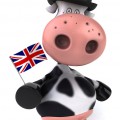As a business, 2020 Marketing Ltd regularly uses stock images from sources like Shutterstock. They are a quick and easy way of complementing communication materials without the need for photo shoots, photographer fees, model fees and license fees. But it often feels like cheating – a short cut with some advantages, but not a hugely motivating experience!
Recently I read about Tesco’s gaff in the UK. They used stock images of beef cattle in a national advertising campaign for milk. Imagine…. Hereford Cross cows in a campaign for milk. I am no farmer, but at a guess, I wouldn’t have thought it very wise to try milking one of these beasts. As one Friesian cow farmer said, “100% of them have never been milked in their lives”.
All major UK newspapers reported the mistake and Tesco, who had originally claimed they were “in touch with their dairy farmers” were forced to withdraw the campaign and start again.
How did this happen? Popular belief is that this came from a culture of “Shutterstock Marketing”. It’s pretty easy to use the search bar to type “cows in England” although it remains a mystery to me that nobody from Westminster popped up. Anyway, that’s another story.
Also, fairly recently, identical images were spotted promoting two completely different services in newspaper ads in Nairobi…. on the same day! Coincidence? Nah. Laughable – you decide.
So be careful. We all use stock images for the same reasons, but to cheapen your campaign to the point of making yourself look foolish is about as smart as trying to milk a bull.
Kevin Bertie – Director


